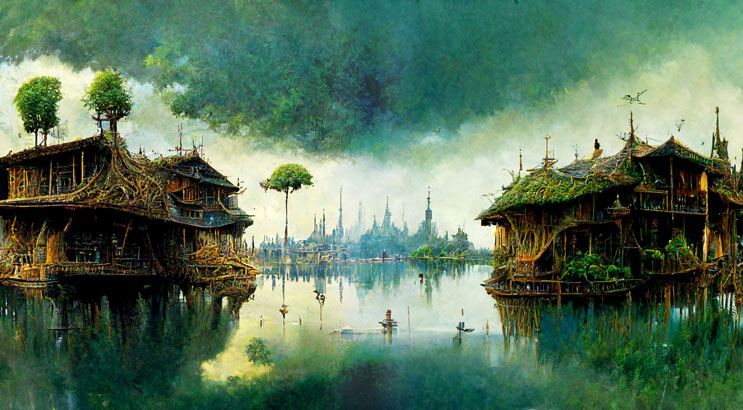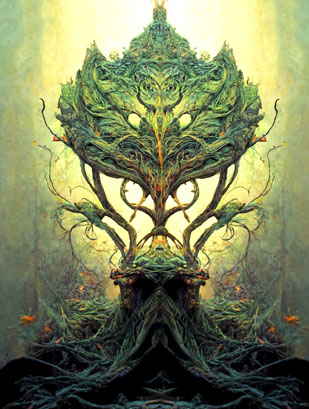Âtogôtaigs of Prigg-Thâgi ('a:.to.'go:.taɪ̯gs ɔf prigg.-'tʰa:.gi)
According to Âdocôdix legends, Prigg-Thâgi is said to have once been the first capital of the Âtogôtaigs within a lake west of the Drûddâci. In addition to the capital Prigg-Thâgi, the Âtogôtaigs were scattered in small settlements around the lake and traded heavily with the city.
In 7,675 BEC, Prigg-Thâgi and its settlements were destroyed by an earthquake. The survivors first moved to the hills and meadows of today's Âdocôris and from there to the distant forests and mountains of the rest of the continent. As a reminder of their capital, they called their new home Brigtagis, which over time developed into today's Brictælgis. The remaining remnants of the lake became swampy and the ruins were soon overgrown and destroyed by forest and Batmùné.
The legend says:
At the end of the Age of Creation, the first Âtogôtaigs were born from the womb of the earth on the banks of the Thoininhi and reaches of the Thointris. They are said to have gone on a journey in the 8th century of the 8th millennium before the founding of the Council (BEC). West of the Drûddâci they found a lake that was many times larger than the Thoininhi. Since there was no shortage of fertile hills, meadows and forests all around, they settled on its banks.Over the next 200 years, many small settlements arose around the lake, each of which was independently "protected" by the village elder. But there were repeated attacks by creatures from the surrounding forests, which the settlers called Gwâpragg, which means mountain shadow. As invasions became more frequent over the next 50 years and cost many settlers their lives, the village elders expressed mutual aid on a Thing should further fighting occur.At 8,583 BEC the Gwâpragg again overran a settlement on the southern part of the lake. Only a few survived and called the other settlers for help. It was time to strike back. A young Âtogôtaig named Âtras devised a plan to pursue the Gwâpragg in the event of another attack and to locate their homes. Days passed before he found her.The mountain shadows lived in caves on the slopes of the Îrwadri. After Âtras had scouted them for a few months and studied their way of life and was able to estimate their approximate number, he made his way home again. The settlers spent the next few months developing a battle plan and preparing for the campaign.On Earth Day, the 2nd of Elgîradi 8,582 BEC, the stars seemed favorable and they went into battle. The Gwâpragg, who had not expected an attack, were surprised by the Âtogôtaigs and defeated in a single battle. For fear of further attacks, the survivors were forced into the caves, which were closed and thus to their eternal grave. Since then, no mountain shadow is said to have been seen again, but even today no one dares go near the Îrwadri caves.For joy and as a reminder of the victory over the Gwâpragg, the Âtogôtais wanted to build a city in the middle of the lake that would connect all the settlements around the lake. They called them Prigg-Thâgi, meaning fruit of victory, and named Âtras the first king of the Âtogôtaigs.unknown author - Scroll of Edifîngâ around 5,460 BEC
The culture of the Âtogôtaigs
Life
Until the fall of their city, the Âtogôtaigs had their first experiences with their earth element, even if the actual power of earth magic was only discovered later. They began to collect herbs and mushrooms and use them for small earth rituals and against illnesses. They were a peace-loving people and already closely connected to the nature of the earth. They lived in multi-story stilt tree houses and decorated the entrances and exits with artfully twisted branches and vines. The roofs were mostly covered with reeds, woven vines and leaves. Several generations lived together in one house. The sleeping rooms were above the living room and the stables for small animals were below. For larger animals there were separate stables that belonged to the entire settlement. The Âtogôtais subsisted on whatever they gathered and grew on small floating islands. Fish, crabs and frogs as well as animals from the neighboring forests rounded off the menu. The Âtogôtaigs spoke Ddral, a proto-language of modern-day Drælgit . Today's Draelgit hardly contains any words from Ddral due to the sound shifts. In particular, the sound P changed into the sound B or the double G sound was replaced by the sound K.Religion
They believed in seven natural deities (earth, rain, wind, sun, moon, fertility, death), whom they honored with simple offerings such as food, colorful stones, flowers and leaves, or small carved figures. For each deity there were long sacrificial stones decorated with runes in the middle of the settlements, which were buried deep in the earth and only peeked out at about waist height. On holy days or when a villager died, the druids of the settlements made offerings on the corresponding sacrificial stones and asked for good harvests, rain, mild winds or a happy afterlife. All the settlement residents then gathered around the sacrificial stones to sing, dance and eat together.Government
The leadership of the Âtogôtaigs was taken over by the village elders. They were advised by the Druids and a small circle of elected settlers. In society, men and women had equal rights, so the settlement council consisted of both genders. At regular meetings of the tribal elders, matters affecting all settlements and the capital were discussed. Since the founding of Prigg-Thâgi, a new king and a royal advisor have also been elected here in a cycle of thirteen Nâritium.King list of
Prigg-Thâgi
The kings and royal advisors were elected every 13 Nâritium, in honor of the 13 Tadi, on the holy day of the city's founding, the 7th Mirtadi, on the Thing of the tribal elders. A king could be re-elected up to three times. If the king died before the next election cycle, the royal advisor was appointed as regent until a new king could be elected on the next 7th Mirtadi.
From 8,582 BEC to 7,675 BEC, 37 kings are said to have ascended the leafy throne of the Âtogôtaigs and six advisors were declared regents. Due to the destruction of the city, only a few kings could be recorded and recorded in the king lists of the Âdocôdix.
8,582 BEC - 8,543 BEC
Âtras I the Great um 8,495 BEC
Brill II the Just 8,400 BEC - 8,361 BEC
Vordo I the Wise um 8,332 BEC
1. Regent Înin the Peaceful um 8,225 BEC
Vordo II the Healer 8,112 BEC - 8,073 BEC
Vindugg I the Funny um 8,025 BEC
Ggildes III the Druid bis 7,902 BEC
Vordo III the Lame one um 7,886 BEC
5. Regent Rilba the Prudent ab 7,886 BEC
Trind IV the Quarrelsome bis 7,682 BEC
Âril III the Blue one 7,682 BEC - 7,675 BEC
Grimgol II the Gentle
Âtras I the Great um 8,495 BEC
Brill II the Just 8,400 BEC - 8,361 BEC
Vordo I the Wise um 8,332 BEC
1. Regent Înin the Peaceful um 8,225 BEC
Vordo II the Healer 8,112 BEC - 8,073 BEC
Vindugg I the Funny um 8,025 BEC
Ggildes III the Druid bis 7,902 BEC
Vordo III the Lame one um 7,886 BEC
5. Regent Rilba the Prudent ab 7,886 BEC
Trind IV the Quarrelsome bis 7,682 BEC
Âril III the Blue one 7,682 BEC - 7,675 BEC
Grimgol II the Gentle








Ein sehr schöner Artikel!
Thematisch, wie optisch sehr ansprechend!
Mir gefällt auch "Die Legende" sehr, baut den Mythos schön auf.